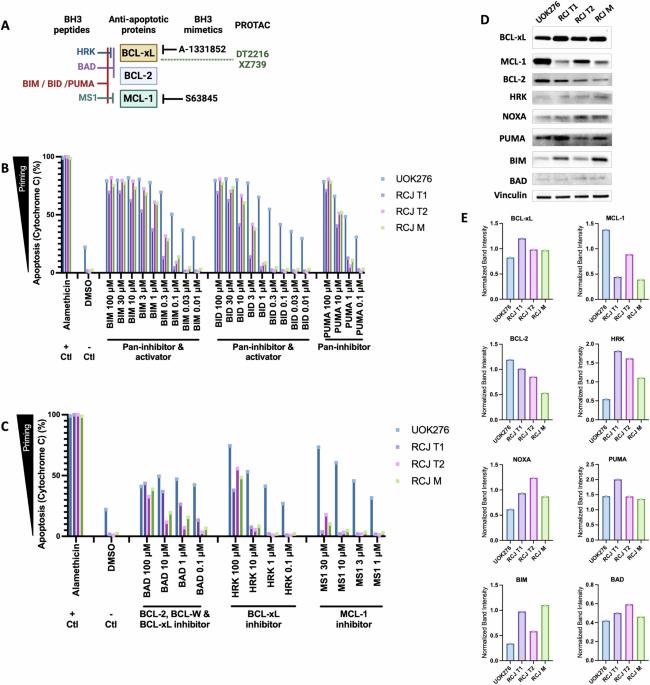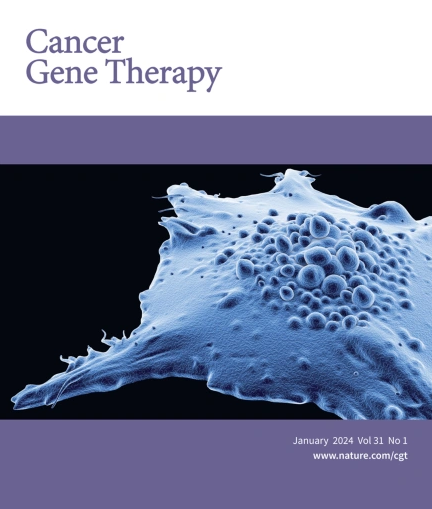BCL-xL在肾细胞癌中的依赖性。
IF 5
3区 医学
Q1 BIOTECHNOLOGY & APPLIED MICROBIOLOGY
引用次数: 0
摘要
憎色性肾细胞癌(ChRCC)是肾癌的第三大常见亚型,治疗选择有限。利用BH3谱分析筛选ChRCC来源的细胞系,我们发现靶向BCL-xL的BH3肽促进ChRCC细胞凋亡。下调BCL2L1足以诱导chrcc来源的细胞凋亡,这与我们的筛选结果一致。编码BCL-xL的BCL2L1在ChRCC中表达量是正常肾脏的4倍,在癌症基因组图谱中表达量第二高。BCL2L1下调可增强MCL-1的表达,提示MCL-1可能具有代偿作用。基于这些结果,我们评估了两种BH3模拟物A-1331852(靶向BCL-xL)和S63845(靶向MCL-1)。它们的结合导致80%的细胞死亡。DT2216是一种蛋白水解靶向嵌合体(PROTAC),靶向BCL-xL降解,诱导裂解PARP和caspase 3,凋亡指标。众所周知,ChRCC细胞对铁下垂高度敏感。我们将A-1331852和S63845与IKE或RSL3(铁致凋亡诱导药物)联合使用。BCL-xL和MCL-1抑制增强了对铁下垂的敏感性,提示ChRCC细胞凋亡与铁下垂之间存在联系。这些数据表明BCL-xL通过抑制细胞凋亡维持ChRCC细胞存活。目前处于临床试验阶段的bcl - xl特异性PROTAC DT2216可能为ChRCC治疗提供机会。本文章由计算机程序翻译,如有差异,请以英文原文为准。

BCL-xL dependency in chromophobe renal cell carcinoma
Chromophobe renal cell carcinoma (ChRCC) is the third most common subtype of kidney cancer, with limited therapeutic options. Using BH3 profiling to screen ChRCC-derived cell lines, we discovered that BH3 peptides targeting BCL-xL promote apoptosis in ChRCC. Downregulation of BCL2L1 is sufficient to induce apoptosis in ChRCC-derived cells, consistent with our screening results. BCL2L1, encoding BCL-xL, is fourfold upregulated in ChRCC compared to normal kidney and has the second highest expression in The Cancer Genome Atlas. BCL2L1 downregulation enhances MCL-1 expression, suggesting a possible compensatory role for MCL-1. Based on these results, we evaluated two BH3 mimetics, A-1331852 (targeting BCL-xL) and S63845 (targeting MCL-1). Their combination resulted in 80% cell death. DT2216, a proteolysis-targeting chimera (PROTAC) that targets BCL-xL for degradation, induced cleaved PARP and caspase 3, indicators of apoptosis. ChRCC cells are known to be highly sensitive to ferroptosis. We combined A-1331852 and S63845 with IKE or RSL3 (ferroptosis-inducing drugs). BCL-xL and MCL-1 inhibition enhanced the susceptibility to ferroptosis, suggesting a link between apoptosis and ferroptosis in ChRCC. These data indicate that BCL-xL maintains ChRCC cell survival by suppressing apoptosis. The BCL-xL-specific PROTAC DT2216, currently in clinical trials, may provide an opportunity for ChRCC therapy.
求助全文
通过发布文献求助,成功后即可免费获取论文全文。
去求助
来源期刊

Cancer gene therapy
医学-生物工程与应用微生物
CiteScore
10.20
自引率
0.00%
发文量
150
审稿时长
4-8 weeks
期刊介绍:
Cancer Gene Therapy is the essential gene and cellular therapy resource for cancer researchers and clinicians, keeping readers up to date with the latest developments in gene and cellular therapies for cancer. The journal publishes original laboratory and clinical research papers, case reports and review articles. Publication topics include RNAi approaches, drug resistance, hematopoietic progenitor cell gene transfer, cancer stem cells, cellular therapies, homologous recombination, ribozyme technology, antisense technology, tumor immunotherapy and tumor suppressors, translational research, cancer therapy, gene delivery systems (viral and non-viral), anti-gene therapy (antisense, siRNA & ribozymes), apoptosis; mechanisms and therapies, vaccine development, immunology and immunotherapy, DNA synthesis and repair.
Cancer Gene Therapy publishes the results of laboratory investigations, preclinical studies, and clinical trials in the field of gene transfer/gene therapy and cellular therapies as applied to cancer research. Types of articles published include original research articles; case reports; brief communications; review articles in the main fields of drug resistance/sensitivity, gene therapy, cellular therapy, tumor suppressor and anti-oncogene therapy, cytokine/tumor immunotherapy, etc.; industry perspectives; and letters to the editor.
 求助内容:
求助内容: 应助结果提醒方式:
应助结果提醒方式:


